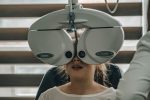Regenxbio details upcoming RGX-381 trial for CLN2 vision loss
First-in-human Phase 1/2 study to test gene therapy in children in UK
Written by |

Regenxbio says it will test RGX-381, its investigational gene therapy for eye problems associated with neuronal ceroid lipofuscinosis type 2 (CLN2) disease, in a first-in-human Phase 1/2 clinical trial that remains on track to begin in the first half of this year.
The trial will evaluate the one-time treatment in children in the U.K., ages 1-12, with CLN2 disease, also known as late infantile Batten disease.
“We remain committed to developing treatments for rare diseases and made significant advancements with our pipeline of treatments for diseases such as Batten,” Kenneth T. Mills, Regenxbio’s president and CEO, said in a company corporate update.
“Our history, science, resources, people and values combine to make us an industry leader in gene therapy and in the development of potentially ground-breaking therapies. We look forward to providing additional updates about our progress in 2023,” Mills added.
Trial will test gene therapy in children ages 1-12
The design of the upcoming Phase 1/2 trial was presented through a poster by Christina Ohnsman, MD, Regenxbio’s senior clinical development lead, at the 19th Annual WORLDSymposium, held Feb. 22-26 in Orlando, Florida.
The poster was titled “RGX-381: First-In-Human Clinical Trial Of An Investigational AAV9 Gene Therapy Encoding TPP1 For The Treatment Of Ocular Manifestations Of CLN2 Batten Disease.”
Most cases of late infantile Batten disease are caused by mutations in the CLN2 gene, which provides instructions for producing an enzyme called tripeptidyl peptidase 1, or TPP1. This enzyme is found in lysosomes, cellular structures that break down and recycle different types of molecules.
Mutations in CLN2 lead to a faulty TPP1 enzyme and the harmful buildup of waste molecules inside lysosomes. This eventually kills cells, particularly nerve cells, triggering the onset of the neurological symptoms that characterize the disease, which include seizures and vision loss.
BioMarin Pharmaceutical’s Brineura (cerliponase alfa) is an approved enzyme replacement therapy for CLN2 disease that provides a lab-made version of the TTP1 enzyme. Infused directly into the fluid surrounding the brain, the therapy helps break down waste and slow progression of motor and language decline.
However, the treatment does not lessen the disease’s eye manifestations.
Administered directly into the space behind the eye’s retina, RGX-381 is a one-time gene therapy that uses a modified and harmless virus to deliver a working copy of the CLN2 gene to cells. The retina is the thin layer at the back of the eye that contains light sensing cells and that is pronouncedly affected in CLN2 disease.
By providing an ongoing source of TPP1 enzyme, the gene therapy is expected to prevent retinal degeneration and vision loss.
We remain committed to developing treatments for rare diseases and made significant advancements with our pipeline of treatments for diseases such as Batten.
In preclinical studies, RGX-381 restored TPP1 production and prevented or reduced lysosomal waste buildup in a dose-dependent manner in lab-grown CLN2 patient-derived retinal models.
In nonhuman primates, a single dose of RGX-381 resulted in elevated and sustained TPP1 levels in several eye fluids over three months without adverse effects. Treated animals showed a more widely spread TPP1 enzyme across retinal areas than untreated animals.
The Phase 1/2 trial will test two doses of the therapy in children, 1-12 years of age, with genetically and molecularly confirmed CLN2 disease. The children must be receiving Brineura and meet other vision and retinal criteria. The study will be conducted at Great Ormond Street Hospital, in London.
The first three children enrolled will receive the lower dose of RGX-381. Following a safety assessment, the next group of three children will be treated with the higher dose. Findings from these two groups will support the testing of the therapy in a larger number of additional children, with a final assessment conducted one year after treatment.
The trial’s primary goal will be to assess the therapy’s safety, while secondary goals include changes in retinal structure and TPP1 levels in the fluid on the front part of the eye. Exploratory outcomes will include changes in vision and detection of immune responses against the therapy.
Regenxbio’s RGX-181, a similar gene therapy for CLN2 disease that’s designed to increase TPP1 production in the brain and spinal cord, was given to a first patient as part of a single-patient study in Brazil.
The clinical development of RGX-181 in the U.S. is currently stalled given requests for additional information by the U.S. Food and Drug Administration. The company has not yet applied for clinical testing of RGX-381 in the U.S.





